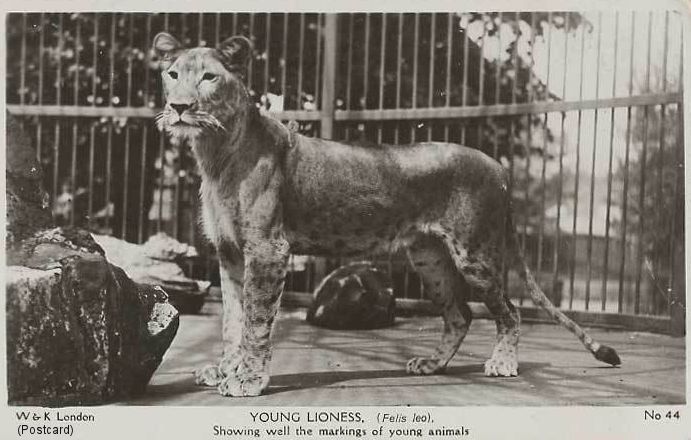
|
MUTANT BIG CATS - SPOTTED & STRIPED LIONS |
Mutants are natural variations which occur due to spontaneous genetic changes or the expression of recessive (hidden) genes. Recessive genes show up when there is too much inbreeding. White tigers and white lions are uncommon in the wild as they lack normal camouflage. Albinism (pure white), chinchilla (white with pale markings) and melanism (black) are the commonest mutations. Erythristic (red), leucistic (partial albinism/cream) and maltesing (blue) are also been reported. Sometimes the markings are aberrant e.g. too sparse or too heavy (abundism), giving the appearance of a pale or dark individual. White, black, red, blue or cream mutations are similar to those found in domestic cats. Sometimes the pattern is different from normal e.g. the blotched King Cheetah or an normally coloured individual may have anomalous black patches (mosaicism) or white patches (partial albinism). Rufism refers to the richness of the red colour in tawny-coated cats.
As well as anomalous colours, there are abnormally large or small individuals, longhaired individuals, short-tailed or even tail-less individuals. All of these occur in domestic cats so why are they less common in big cats? Wild cats displaying these traits may be less likely to survive to pass on the traits. In captivity, humans control which traits are bred, hence the multitude of domestic cat colours and types. In the wild, nature selects against any trait which does not enhance the animal's survival chances.
In the past, the obvious reaction to any unusual big cat was to shoot it for the trophy room. As a result, many interesting mutations may have been wiped out before the genes were passed on. Some colour mutations which would disadvantage a wild big cat are bred in captivity and are not viable in the wild. It is questionable whether these mutants should be perpetuated for the sake of curiosity or aesthetics alone.
SPOTTED LIONS
Lion cubs are spotted or rosetted for camouflage. They normally lose their spots when they reach adulthood. There are numerous sightings of spotted lions and a number have been shot and the pelts displayed. Young adult lions often have markings which are clearly visible in certain light and some retain strong markings. There is also the less likely explanation that the spotted lions are leopons - lion x leopard hybrids. These have been bred in captivity although the leopard is much smaller than the lioness. There are African legends of naturally occurring leopons and there has been one report of a solitary lioness accepting a leopard as a mate and producing hybrid cubs. In the wild, this would only occur where a lioness is unable to find a male of her own species. The spotted lion, where there is good contract between the spot colour and the background, probably represents a natural variation.

When suggesting that the marozi is a lion-leopard hybrid it is necessary to understand that a person describing it as "a cross between lion and leopard" may simply mean it bears resemblance to both of those creatures and does not mean it is literally a hybrid. The first observations of spotted lions (marozi, Panthera leo maculatus) by westerners were made by Colonel Richard Meinertzhagan in 1903 when he described darker lions with rosette-like markings in the Kenyan mountains. Meinertzhagen had heard of the marozi several times between 1903 and 1908, but no official notice was taken of it and it was probably dismissed as native myth.
In 1924, Captain A Blayney Percival, renowned game warden and brilliant naturalist (in the days when this meant shooting things!), reported killing a lioness and her cubs which were all very clearly spotted. The lioness was described as being no less spotted than her cubs. It was possible some individuals retained their juvenile spotting much later than usual. The existence of cubs is often cited as evidence that the spotted lioness could not have been a leopon hybrid. However, female big cat hybrids are often fertile, producing offspring if mated to a non-hybrid big cat. It is the male hybrid that is sterile.
In 1931 Captain RE Dent, Kenyan game warden in charge of the Fisheries section, observed 4 spotted lions crossing the path in front of him, between 10,000 and 11,000 feet up, near the source of the Kathita above Meru. These lions seemed darker and smaller than normal lions and "of a very different type". Dent seemed to forget about them until a few months later when his boys, who had set leopard-traps all along the eastern slopes of the Aberdare Range, excitedly told him that they had caught an unusual animal that was neither a lion nor leopard, but some sort of cross between the two. For some unknown reason they were unable to bring the specimen back and had not preserved the skin of this spotted lion.
An Irish adventurer and author of the book "Nomad" (1934), C.J. McGuinness, wrote that Carl Hagenbeck (animal collector for Hamburg Tierpark and breeder of many big cat hybrids) had himself sighted a spotted lion.
There were also reports of a spotted lion being trapped and killed around 1931. The main evidence comes from skins obtained in 1931 when Michael Trent, a white farmer in the Aberdare Mountains of Kenya, shot 2 small lions, one male and one female with strange fur. They had been attracted to a waterbuck fixed as bait some 10,000 up in the Aberdares. Trent was not a naturalist and took little notice of their odd appearance, but preserved the skins as trophies. The skins later caught the attention of an official in the Game Department who considered them unusual enough to be taken to Nairobi to Chief Game Warden Captain ATA Ritchie. The skins were examined by Game Department officials in Nairobi and Ritchie recognised that they were unusual. The skins belonged to a lion and a lioness, though the mane on the male's skin consisted of little more than side-whiskers. From their size they seemed to belong to lions at least 3 years old (i.e. of pubescent age) and were probably a lion and his mate. Unusually, the skins were spotted although lion cubs normally lose their juvenile spotting well before 3 years old. The skins were clearly spotted, and the spots showed no signs of fading. Lacking a complete skeleton, or at least a skull, which could have definitely established the specimen's age (and probably species), it was hard for the Game Department officials to give a verdict.
The Coventry Evening Telegraph (28th August 1939) tells us of the spotted lions seen in 1931. There has for many years been a legend in East Africa that spotted lions exist there. The sceptical have been inclined to make the obvious remarks anent the illusions created by intemperance, but evidence accumulated and vouched for by eye-witnesses whose veracity was beyond doubt established to the satisfaction of the authorities that above certain altitudes lions develop characteristics different from those of the lower plains. In 1931 Mr. Dent in the Government Game Department actually saw spotted lions cross his path, while later from a farm in the mountains came the skins of two lions which had been shot and sure enough there were the spots. Eventually as with the Loch Ness Monster an official expedition went out specifically to hunt for the elusive creature. Traps were set but only leopards were caught, and although the mission came back spotless, the existence of the spotted lion as a distinct species has been accepted.
Kenneth Gandar Dower went to Africa, fuelled by the tales of H. Rider Haggard, in search of adventure in the "dark continent." He admitted that he was ill-equipped for his adventure – he had had only ten riding lessons as a boy, was not accomplished with either a camera or a rifle and spoke minimal Swahili. Luckily he had a zest for adventure, a sense of humour and was the sort of big-game hunter who preferred to capture rather than kill the sought after spotted lion. Gandar Dower examined Trent's skins and wrote: "They appear to belong to lions two or three years old - the male had a whiskery mane - and yet the cub spots with which almost every lion is born showed no signs of fading. Certain freak lions do keep their spots to an advanced age, but not in a degree comparable with these rosettes which were distributed not only on the legs and flanks, but right up to the spine itself."
This, along with Blayney Percival's spotted lioness shot in 1924, convinced Gandar Dower that a separate species of spotted lion existed and in 1933 he, accompanied by the more sceptical Raymond Hook, organised a safari to look for specimens. In his safari book "The Spotted Lion" (1937), the 26 year old African adventurer Gandar Dower wrote: "Mine was not a promising situation when I found myself stranded in Nairobi. My only assets were a love of Rider Haggard and a vague half-knowledge of what I wished to do. I wanted to see big game in their natural surroundings, to take their photographs, and, once that was done, to fit myself to go alone into the great forests. I wanted to discover and to explore. Yet I could not speak Swahili. I had no fiends in Kenya. I had scarcely taken a still photograph (that had come out) or fired a rifle (except upon a range). My riding was limited to ten lessons, taken seventeen years previously when I was nine, on a horse which would barely canter. My shy suggestions of the possibilities of new animals brought only rather scornful jokes about the Naivasha Sea Serpent and the Nandi Bear. [...] This opportunity, given so undeservedly to a novice, who three months ago had never been to Africa or really ridden a horse or fired a rifle at a living thing, was almost too great a responsibility to bear. I felt small. Even with Raymond's help, how could I hope to find this rare animal, the very existence of which had for so long been unsuspected, in 2000 square miles of wilderness, through which we could hardly travel, to find it and track it down, and shoot it, or photograph it and capture it alive?"
The Penrith Observer (29th October, 1935) announced the quest: HUNTING SPOTTED LION. Expedition by Captain Dower's Brother. Mr. K. C. Gandar Dower,_brother of Capt. Alan Dower, the National Conservative Candidate for the Penrith and Cockermouth Division, is to make a search in the mountain, of Kenya for spotted lions which he is convinced live there. He will be joined by a friend when he gets to Africa, and they will use a number of local hounds whose job will be to follow the spoor of the spotted lion. It is hoped to bring back a specimen for the British Museum, and also if possible to capture a live animal for the London Zoo. Spotted lions, are rare and this will be Mr. Dower's second expedition in search of spotted lion, and he leaves at the end of November on what will be a four months quest. From the Daily Herald (HUNTING THE SPOTTED LION - 21st November, 1935) we can see that "Mr Gandar Dower left Croydon by air liner yesterday for Kenya. where he will probably remain for four months, seeking specimens of the spotted lion, which he believes exists at a height of over 10,000 feet in the equatorial mountains."
The London Daily News, 23rd October 1935, pg 4 (TRACKING SPOTTED LIONS. MOUNTAIN HUNT WITH HOUNDS), describes Gandar Dower's proposed second hunt for the spotted lion in greater detail. "Hounds will be used by Mr. K. C. Gandar-Dower, the well known London sportsman, tennis player and airman, when he makes a search in the mountains of Kenya that will be as exciting as anything in Rider Haggard. The hounds are to follow the spoor of the spotted lions which Mr. Gandar-Dower is convinced live there. A skin taken from a spotted lion by natives has been submitted to the British Museum authorities by Mr. Gandar-Dower, and they agree it is very much more marked than any skin of a lion of that age they have hitherto seen. "Before they can classify the spotted lion, however," he told me today, "they must have a complete skeleton, skin and skull of a mature beast, and that is why I am leaving for Africa at the end of November. A friend will join me when I get out there and I expect the whole job will occupy us for four months at least. We shall use local hounds of mixed types to follow the spoor of the lions. Years ago it was usual to hunt lions with hounds and we hope to bring back a dead specimen at least. The spotted lions are very difficult to trap, but we also intend. if possible, to bring home a live one for the London Zoo." This will be Mr Gandar-Dower's second expedition in search of the spotted lions. On the previous occasion one of his native boys saw a spotted lion, and Mr. Gandar-Dower has examined the trail left by the animals. "The spotted lion apparently has a small mane," he added, "but all knowledge of it so far is very sketchy."
Upon his return he gave a series of talks about his adventures, as reported by the Leeds Mercury (7th September, 1936): "It was with a sense of lively curiosity that I turned to Mr. Gander Dower's talk on the Spotted Lion, which had nothing to do with the Red Lion or any other pub, but purported to be a mysterious animal that tradition had it existed in the Kenya Country of East Africa. This seemed to promise something of a cross between a lion and a leopard, but Mr. Dower could do nothing to enlighten us, as he had not seen one, though he had met those who claimed they had."

Edinburgh Evening News (28th September 1937, pg 6) reports "Mr K. C. Gandar-Dower, the athlete, is an admirer of the works of Rider Haggard, John Masefield, and A. A. Milne. Yesterday he published a travel book called "The Spotted Lion," which he describes as "an appeal for the Rider Haggard point of view." Mr Gandar-Dower went to Africa determined to find it as dark as it has been painted. He chafed against what he calls its increasing "Bognorisation," and went off into the Aberdare Mountains, in Kenya, to search for a spotted lion. This animal is said to be smaller than the ordinary lion and spotted like a leopard. Sceptics declare it to be mythical. Mr Gandar-Dower failed to prove that it is not, but, short of actually shooting one, produces some remarkable evidence for its existence" and the Aberdeen Press and Journal (5th October, 1937) tells us "Rumours of an unidentified lion in the Aberdare mountains led to an expedition into the real uncharted Africa. The Aberdares are uninhabited. "Because of their situation they were easy to reach; because of their character they were difficult to penetrate. No one had been moved to hunt lions in the belt of trees between the 9000 feet and the 11,500 feet levels because it could be done much more easily almost anywhere else." Whether or not a spotted lion actually exists is very far from clear, but the story of the hunt for such a beast certainly makes most excellent reading, illustrated with a profusion of fine photographs."
And while he may not have captured a spotted lion, he did explore previously unknown regions, discovered a lake, and wrote a book about his adventures. "The Spotted Lion," by Kenneth Gandar Dower (8s 6d . Heinemann.) was reviewed in The Scotsman (5th November, 1937). "Mr Gandar Dower went to Africa with limited skill in horsemanship, no knowledge of shooting , and little of the art of photography . He had, however, a strong desire to see the Africa of Rider Haggard. I came hurriedly," he says, because I hoped to get my peep at the last gutterings of the mystery that once was Africa . . . to hear the calls that only fifty years ago used to echo unbroken for hundreds of miles across her rolling wastes. I wanted to hear her hunting lions roar before they have wisely ceased to roar, or only roar to order on the Serengetti plains." First he found the man to guide him in the ways of the hunter and explorer; then he found his quest the half-legendary spotted lion said to inhabit the upper jungles of Mount Kenya; and in that quest which led him to the Aberdare mountains he found the untamed Africa which he sought. Mr Gandar Dower did not find the spotted lion, though he still has hopes of doing so, but the story of his various expeditions, lightly and vividly told, is rich in incident . He and his party journeyed through little-known country. There has been a joy in the search," he writes, "in the battling with rain and bogs, in the skirmishes with elephant and rhino, in the hunt of the giant hog [the first specimen of which he captured] in immense distances viewed from immense heights in light and shade striking down a forest glade, in the spur of a quest." "
Gandar Dower's "The Spotted Lion" was about their expeditions in general, not just the search for the marozi. Despite Hook's scepticism, he was hopeful of finding - and shooting - spotted lions. He found nothing apart from some footprints; the larger track was larger that leopard tracks, but too small for a lion and which could not have been a young lion. The animals appeared to be stalking a buffalo and were therefore adults. At an elevation of 12,500 feet, lion tracks were found and were believed to be those of a male and female pair of marozi (spotted lions) due to the location. A Kenyan guide, Ali, had described his meeting with a pair of marozi to Gandar Dower two weeks previously. The animals, a male and female, were playing in the sun and were smaller and more slightly built than a lion, but were mottled all over with a sparse mane. At one point, Hook and Gandar Dower missed seeing a spotted lion, apparently arriving a single day too late.
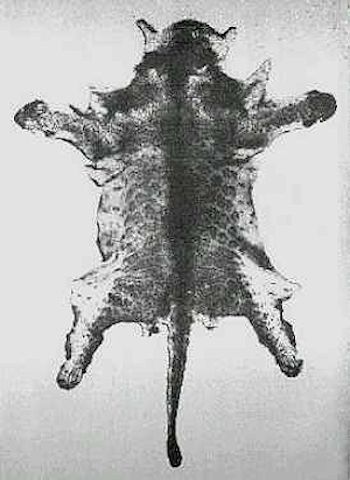 Spotted lion skin from 1931 |
The Illustrated London News (30th October, 1937) gave a long review of his book, It was refreshing, therefore, to find something quite out of the ordinary in The Spotted Lion." By Kenneth Gandar Dower. With twenty-seven Illustrations and Map (Heinemann ; 8s. 6d.). Mr. Gandar Dower, whose name is not unfamiliar to our readers, relates his adventures mainly in light, ironical vein which is vastly entertaining, and much of the time he is making fun of himself, his mishaps and pretended ineptitudes as a raw hand at the game. A writer who can laugh at himself is always genial towards others, and his description of his companions (especially Raymond Hook), the native hunters, the horses, donkeys, and dogs, and the various vicissitudes of the expedition, makes a most beguiling story. Moreover, he has a polished style which gives his narrative distinction even in its lightest moments. Nor does he lack descriptive power (although used with economy) in face of Nature s grandeur in the mountains of Kenya. He is serious when denouncing (to use his word) the Bognorisation" of Africa. [. . .] What really attracted him in Africa was the discovery that one last mystery remained unsolved the rumour that there existed in the upper forests of Mount Kenya (between 9000 and 11,500 ft.) an unverified type of lion, smaller than ordinary lions, one that was spotted as completely as a leopard." Thus came about the Spotted Lion Expedition, which forms the central interest of the book. The frontispiece shows the skin of a spotted lion - one of two killed by a man farming in the Aberdares at the almost unbelievable height of 10,000 it." Were these skins freaks?" asks the author. "Did they belong to ordinary lions that, because of their abnormal development, had retained their cub spots longer than usual? Or had lions taken to living this queer life so long ago that they had developed new characteristics? Or did they belong to an entirely new species of great cat?
The tale of the Spotted Lion Expedition, as Mr. Gandar Dower tells it with his inimitable verve, is intensely interesting, but the results were inconclusive. On his return to England he encountered much facetious unbelief, yet the more competent the zoologist, the less he bristled with scientific scepticism. Six months passed, but no news came of a spotted lion entering any of the traps that had been left. In the end, writes the author, I decided to go back. The story of that visit to Africa has no place in this book. Some day, perhaps, shall tell how I journeyed into the Mufumbiro Mountains, whence the story had come of jaguar-like lions that dwelt in the gorilla country. ... Of how, after many failures, Ali and I captured the first specimens of the giant forest hog. Once again the quest of the spotted lion proved unsuccessful, but the author s faith is unshaken. Somewhere amid the gorges of Mount Sattima, somewhere amid the giant heather of Kenya above Embu or Meru, somewhere, perhaps, among the bamboos and bogland of the Mufumbiro Mountains, lives what may prove to be the last of the world s zoological wonders.
Gandar Dower's book "The Spotted Lion" attracted a great deal of attention and brought more evidence to light. After his account in 1935, the British weekly hunting journal "The Field" carried occasional accounts of spotted lions. In 1935, "The Field" printed a letter and photo by Andrew Fowle, regarding a normal-sized lion aged two years but still possessing distinct spotting. Towards the end of 1937 a letter appeared by BV Richardson, who had made contact with settlers and natives in the area explored by Dower; Richardson had never heard any of these people speak of spotted lions. He remarked that the natives sometimes exaggerated in an attempt to please their masters (contradictory answers given by the Kikuyu people to Hamilton Snowball and Pollard support this view).
The most interesting evidence came from G Hamilton-Snowball, who reported an interesting adventure in the Aberdare Range. Hamilton-Snowball recalled learning of the marozi prior to Dower's 1935 expedition. In a letter to The Field (1948), Hamilton-Snowball recalled shooting what he first took to be a leopard, although it was unusually large and dark in colour. His Kikuyu boys told him that it was a damasia, not a chui (leopard), and that it was as different from a leopard as a lion from a marozi. When Hamilton-Snowball asked them what a marozi was, they immediately replied that it was an animal smaller than a lion, which one usually met in pairs, though this happened rarely and only at high altitudes, and that it was spotted.
Hamilton-Snowball may even have spotted a pair of these animals, identified by native guides as marozi, at an elevation of 11,500 feet along the Kinangop Plateau: Later, in the spring of 1923, I crossed the Aberdares on foot from Laikipia to N jabini on the Kinangop plateau and on the second day out, about 4 p.m. in poor light (it was drizzling a bit) at 11,500 ft. I saw what I thought at first were two very tawny and washed out looking leopards about 200 yards away. As I turned to my bearer for my rifle (I had been carrying a shot gun) I heard an unfamiliar name being excitedly murmured by all the boys, who had seen the beasts as soon as I had. Marozi, Marozi, they repeated. As I pushed off the safety catch, with one movement, the beasts (or cats) turned and in two bounds had gone into the belt of forest in front of which I bad surprised them. By now I remembered what Marozi meant and asked the boys if they thought it was likely a couple of lion would ever come up from the plains to such a height and in such cold conditions! Certainly not, they said, but Marozis live here! Well, I can only say or tell of what I had seen and I must add that the pugs certainly were those of lion, and not of leopard, that the beasts looked spotty and tawny, but except for the natives, I never could get confirmation that there even were such things as spotted lions. Further enquiry found that the Kikuyu people made a clear distinction between simba (lion) and marozi (little spotted mountain lion). His attendants told him that lions did not ascend to such mountainous heights but affirmed that marozis lived at that altitude.
In 1948, JRT Pollard wrote (in The Field) that Raymond Hook, who had accompanied Gandar Dower's expedition and who had unique knowledge of the high parts of Kenya, believed the spotted lion (as a species) to be largely mythical. Hook acknowledged the possible existence of a small race of lions surviving in confined areas, possibly driven into the mountainous forests by European settlers. This sub-species, if it existed, would have undergone a change in colour to suit its new environment. However, Hook felt that there was insufficient evidence to support a fully fledged spotted race. However, Pollard believed an unknown felid was possible.
Pollard recalled that Powys Cobb of Elementeita (an expert on African big game) had chased an unusual cat trespassing on his farm, near the Mau Forest's edge. Cobb had described it as intermediate in size between a lion and leopard and it had left behind spoor resembling that of a small lion. Cobb was convinced that an undiscovered species lived in the thick and little-explored Mau forest. Cobb had surprised the strange big cat after it attacked cattle grazing in a corner of his farm near the edge of the forest. He pursued it on horseback into the forest where he had to give up the chase without getting any closer to it. Its footprints were like those of a small lion.
However, G Flett of Aberdeen suggested that Cobb had been deceived by dappled shadows into believing he had seen a spotted lion. Flett's scepticism was based on personal experience. While this might account for some sightings, it did not account for Michael Trent's spotted skins. Flett wrote: On two occasions during my two years continuous stay in the remoter parts of Kenya, I met with lions at very close range during the middle of the day; on both occasions the bodies of the animals were patterned by the shadows thrown by the tree branches and the shadow effect was indeed striking. I thought then that I had seen a species of lion unknown to science and I can well understand how Mr Pollard s friend was deceived.
Colonel C. R. S. Pitman, a game-warden considered to be one of the most knowledgeable experts on African fauna, wrote: The evidence, so far, is inconclusive, though there is no reason to discredit the probability of a small race of lion occurring permanently at these high altitudes [10,000 and 11,000 feet]. My own ideas support the claim that a small mountain race does exist in Kenya.
The opinions of Hook and Cobb were quoted after Gandar Dower s death, by another East African settler, JRT Pollard, who had known Gandar Dower well. Pollard also wrote in 1948: My own view, based on talks I have had with Kikuyus, many of whom assert that lions occasionally visit the high moors of Mount Kenya, is that it is quite possible that an unknown member of the cat tribe inhabits the upland rain forests, for large areas have never been visited by man. This contradicts the account of Hamilton-Snowball regarding lions at those altitude and suggests the Kikuyu were telling Hamilton-Snowball and Pollard what they thought the men wanted to hear.
The big game hunter and sceptic E A Temple-Perkins mentioned a similar animal called ntarago. Having heard its voice he was inclined to believe in its existence: The voice I heard that evening at Kichwamba was strangeness itself, and beyond my power to describe with sufficient accuracy, although I beard it at ranges of about one mile to fifty yards from my camp intermittently for two hours. All I can say is that it sounded harsh and guttural; it was not the cough of a leopard, but more like that than anything else if you add the word liquid or gurgling.
Four natives, including an old and trusted tracker, independently told Temple-Perkins that it was the call of the ntarago. The hunter never saw it or its spoor, but remained insistent that the ntarago was a feline, and was emphatic that it was not the equally mysterious "giant hyena"
The natives of Embu told Major G St J Orde-Brown about lion-like "forest cheetah on the south-eastern slopes of Mount Kenya. It seemed likely that this was the spotted lion, due to the similarity in outline of a cheetah and a lion: high shoulders and often walking with raised head, while the leopard walks with its head farther forward, and lower than its shoulders.
In 1950, The Field published a full-page discourse The Legendary Spotted Lion by Major W. Robert Foran. Foran was sceptical of the existence of a race of spotted lions. Foran recalls that zoologists of the time only recognised 2 varieties of lion in East Africa, the Masai lion (massaica). Foran favoured the idea that some individuals of the smaller, paler and sparsely-maned Somali lion (Panthera leo somalica) had somehow wandered into the Aberdares region of Kenya. Foran, wrote in his article: On two different occasions in 1906 1 shot a lion and a lioness on the slopes of Mount Kenya, each definitely not younger than five years old; the spotting was clearly visible on belly, flanks and legs. Both were somewhat smaller than the average lion and the male was quite maneless. It struck me that these animals were abnormal in the retention of their spotting, but were possibly a rare occurrence. [ ] There is nothing unusual in lions being found at such high altitudes: they are customarily styled forest lions, and on average, they are smaller than normal beasts found on the plains at lower altitudes.
Foran suggested that the marozi could be out-of-place Somali lions that had included some aberrant spotted individuals and concluded by stating that he would await further developments in order to solve the spotted lion riddle conclusively. There were no further developments. Some marozi reports trickled in during the Mau Mau's invasion of the Aberdares in 1952, but apart from that, interest waned until comparatively recently when the science of cryptozoology became acceptable.
For the first half of the 20th century there were continued rumours of a spotted lion in Upper Kenya above Meru. Each witness reported it to be smaller than an adult lion and nearer in size to a cheetah, with leopard-like spots and little or no mane. While most naturalists were dubious, Reginald Pocock (considered an authority on wild felines), found it plausible and wrote of 2 unusually small lion skulls he had received (unfortunately without skins, spotted or otherwise):
There is, as a matter of fact, some independent evidence, unknown to Mr Gandar Dower at the time, of the evidence of a small lion in Kenya. Several years ago, Messrs. Rowland Ward showed me the skulls of an adult lion and lioness received without skins or more precise locality from that Colony. Their unusually small dimensions puzzled me a good deal. The skull of the lion was less than an inch longer than the longest lioness s skull, from Laikipia, in the Washington collection, and the same width; and the skull of the lioness was nearly 1 in. shorter and over an inch narrower than the smallest lioness s skull, from Kapiti, in the same collection.
Since these skulls are decidedly smaller, sex for sex, than any out of the very large numbers that have been measured from many localities in the plains of East Africa, it seems probable that they came from some place in Kenya where few sportsmen have shot and preserved lions. That place may have been the mountain forests of the Aberdares,
Heuvelmans "On The Track of Unknown Animals" (1970), summarised some of the reports and referred to the "marozi, the little spotted lion of the Kenya mountains."
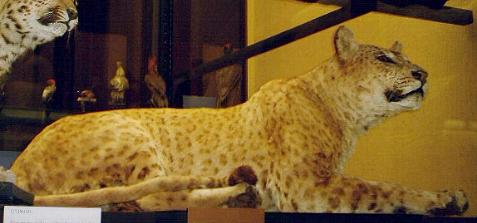 This "spotted lion" is labelled as a lion/jaguar hybrid, but is more likely to be the famous Congolese Spotted Lion - a cross between a lion and a female leopard/jaguar hybrid. |
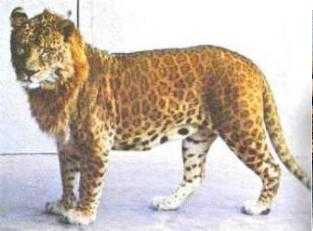 This "spotted lion" is a leopard/lion hybrid |
The Trent Specimen Skins
The skin, and possible skull, of one of the two spotted lions shot by Michael Trent in 1931 is held at the Natural History Museum in London. RI Pocock of the Natural History Museum in London examined the specimens prior to 1937 and made the following report:
"It is a male, measuring approximately: - head and body 5ft. 101/2 in., tail, without terminal hairs of the tuft, 2 ft. 9 in., making a total of about 8 ft. 8 in. This is of course small for adult East African lions, of which the dressed skins may surpass 10 ft. over all. From its size I guessed it to be about three years old, a year or more short of full size.
There is nothing particularly noticeable in its mane, which is small and, except on the cheeks, consists of a mixture of tawny, grey and black hairs, the longest up to about 5 in. in length. ... the peculiarity of the skin lies in the distinctness of the pattern of spots, consisting of large "jaguarine" rosettes arranged in obliquely vertical lines and extending over the flanks, shoulders and thighs up to the darker spinal area where they disappear. They are irregular in size and shape, the largest measuring 85 by 45 or 65 by 65 mm. In diameter. Their general hue is pale greyish-brown, with slightly darkened centres, but at the periphery they are thrown into relief by the paler tint of the spaces between them. On the pale cream-buff belly, the solid richer buff spots stand out tolerably clearly. The legs are covered with solid spots, more distinct than the rosettes of the flanks, and on the hind legs they are more scattered and a deeper, more smoky grey tint than on the fore legs.
The skulls of the pair of spotted lions secured by Mr. Trent were not preserved when the animals were skinned; but a skull presumed to belong to one of them, with all the teeth and the lower jaw missing, was subsequently picked up near the spot and submitted to me with the skin. It is a young skull with all the sutures open, showing it had not attained full size and may well be the estimated age of the skin. It is not sufficiently developed to be sexed with certainty ... The skull in question may prove to be that of a slightly dwarfed lion with the teeth and skull reduced to about the size of those of an ordinary lioness."
Although the skin and skull have been re-examined since, there is little to add to Pocock's report. DNA studies might cast more light on the enigma. Current knowledge suggest that the marozi (or "Aberdares Spotted Lion") is a small, sparsely maned lion intermediate in size between a lion and a leopard. Unlike the pride-living lion, it travels in male-female pairs, although a foursome has been reported, possibly being a pair with sub-adult offspring. Similar spotted lions have been reported in other parts of Africa. Modern tourist information refers to the Aberdares lions as being more hairy and spotted than plains lions.
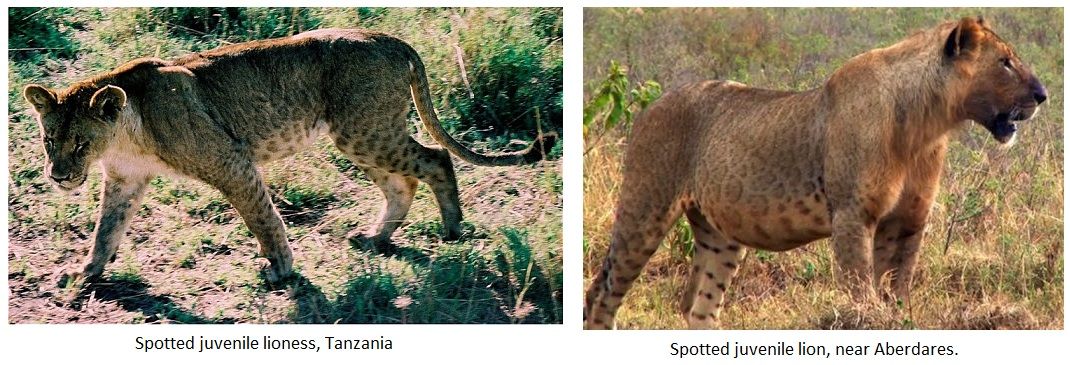
Hypothetical Taxonomic Classification
At the time of the marozi sightings, there was debate over whether African lions (Leo leo) and Asiatic lions (Leo goojratensis) were different species, let alone the possibility of different sub-species of African lion! Dr Frechkop accepted that there were marked differences between Barbary lions, Cape lions and a few others, but opposed the creation of a host of subspecies, feeling that many differences were simply due to individual variability within a single race of lions.
Although taxonomists seemed eager to create new (sub)species based on minor differences, they remained unwilling to recognise the Spotted lion as a separate variety in spite of its distinctive appearance. The name Leo maculates was suggested (this has since become Leo leo maculates, a hypothetical subspecies).
Its possible origins could have been an isolated population that had become adapted to forest living, dwindling in size and retaining spotted markings. While not unusual to find lions on mountains, it is unusual to find them in thick forests. Heuvelmans hypothesised that if a forest subspecies existed it would likely be smaller that the savannah lion and have a spotted coat for camouflage. He based this on Dr Serge Frechkop's has note about leopards, there is as a general rule a type of larger size with a lighter coat in the savannah, and a type of smaller size with a darker coat in the forest.
While a large lion is 5 feet 3 inches long (nose tip to base of tail), and a large leopard is 4 feet long, an adult spotted lion would be about 4 feet 8 inches long. It might even be smaller due to its sometime comparison with the cheetah (3 feet 3 inches), which would make it a pygmy lion (Leo leo nanus).
Alternatively, were it to prove a completely separate species, it might be designated Leo marozi or Leo leo marozi reflecting the native name for it.
Spotted lions have captured public imagination so much that they have been artificially created: leopons in Japan, jaglions in Germany and the "Congolese Spotted Lion" exhibited in London in 1908. The Congolese Spotted Lion was the result of a female jaguar/leopard hybrid that had been mated to a lion in a Chicago zoo.
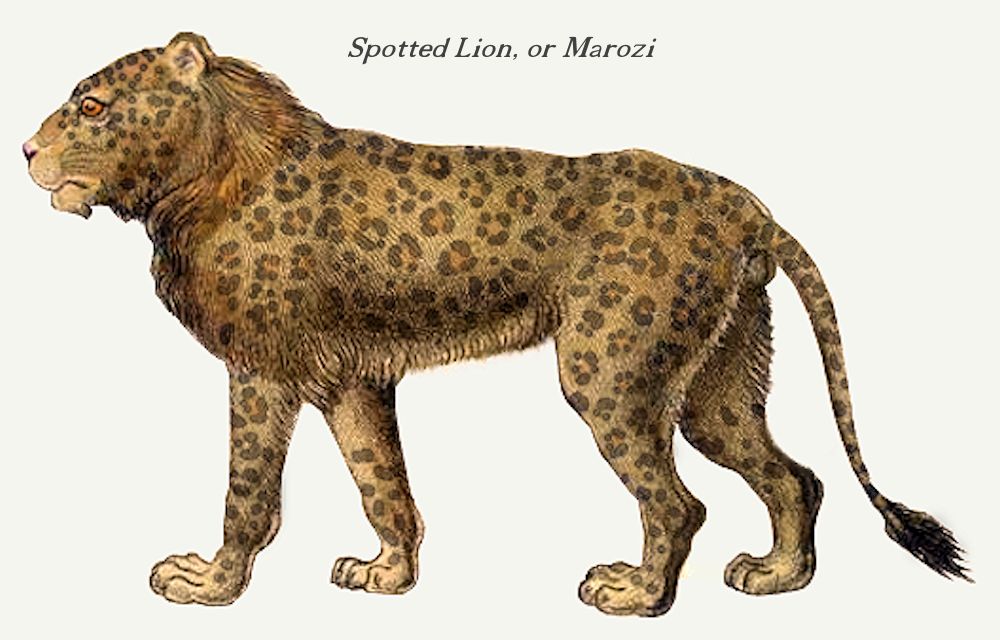
STRIPED LIONS
Striped lions are mentioned by Marco Polo in his descriptions of his travels in the late 1th and early 13th century. I have used the text from The Travels of Marco Polo for Boys and Girls, with Explanatory Notes and Comments, by Thomas W. Knox, 1885. [The Emperor] hath also several great Lions, bigger than those of Babylonia, beasts whose skins are colored in the most beautiful way, being striped all along the sides with black, red, and white. These are trained to catch boars and wild cattle, bears, wild asses, stags, and other great or fierce beasts. . . . The two audience-tents and the sleeping-chamber are constructed in this way. Each of the audience-tents has three poles, which are of spice-wood, and are most artfully covered with lions' skins, striped with black and white and red, so that they do not suffer from any weather. All three apartments are also covered outside with similar skins of striped lions, a substance that lasts for ever.
The Persian Language in Yuan-Dynasty China: A Reappraisal, by Stephen G. Haw, is very helpful in unravelling the use of striped lion when the animal is clearly to modern readers a tiger. Haw suggested that neither Marco nor Rustichello (who co-wrote Marco s autobiography) knew a specific word for tiger, because the tiger was virtually unknown to mediaeval Europeans. Haw pointed out that Odoric of Pordenone (a missionary explorer) also referred to lions in China, saying that black lions in very great numbers are found in India. It is clear that these were black panthers (black leopards). Odoric s usage of the word suggests that mediaeval Europeans used lion as a general word for any big cat. Most mediaeval Europeans probably had no clear idea of what kind of animal a tiger was (in some twelfth-century bestiaries it was described as type of serpent and depicted as a winged dragon). The best way to describe a tiger is to compare it to a more familiar animal a lion, but with striped. Neither Marco nor Rustichello would have been likely to identify the striped lions that Marco saw in China as tigers. In the 18th and early 19th century, the term tiger was often used by Europeans as the generic word for big cat e.g. South American tigers (jaguars) and black tigers (black leopards).
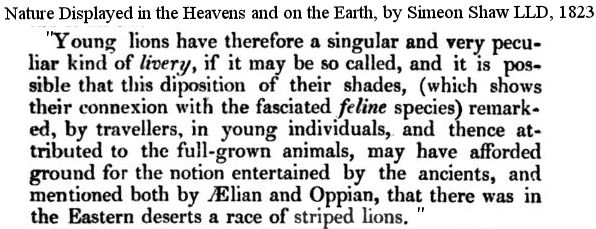
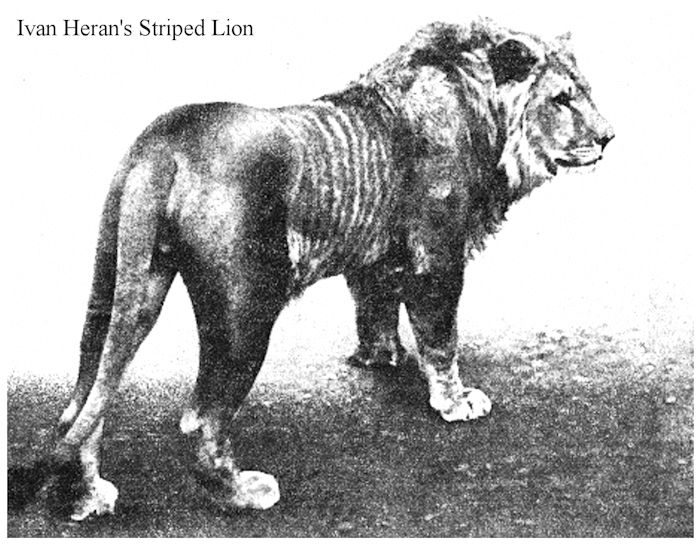
Even in adult lions, which appear solid coloured at first glance, spotted and rosetted markings are discernible in certain light and at close quarters. C A W. Guggisberg, author of "Wild Cats of the World," noted that the spots of some lion cubs are arranged vertically and and occasionally these merge to form stripes (similar to the stripes seen on lion-tiger hybrids). Usually the juvenile spots -and any merged spots or stripes - fade to near invisibility as the lion reaches maturity. Occasionally a lion retains its juvenile markings into adulthood and Ivan Heran included a photo of an apparently striped adult male lion in the 1976 book "Animal Coloration." I say "apparently striped" because a similar visual effect can be created by rippled fur, especially be rippled damp fur.
In Striped Lions and Stripeless Tigers published in the Field (a sporting/hunting magazine) in 1932, Pocock described the variability of captive-bred lion-tiger hybrids. It was a topical subject because of the recent death of the well-known tigon hybrid at London Zoo. The London Zoo hybrid, bred in India, resembled a lioness with faint stripes; and although male, it had a tiger-like frill rather than a lion s mane. Pocock had also met with a specimen where the colour was so rich that it resembled a stripeless orange tiger. (Pocock, R. I. Striped Lions and Stripeless Tigers. Field, London, vol. 159, no. 4127, p. 149, January 30, 1932. )

Textual content is licensed under the GFDL.
For more information on the genetics of colour and pattern:
Robinson's Genetics for Cat Breeders & Veterinarians 4th Ed (the current version)
Genetics for Cat Breeders, 3rd Ed by Roy Robinson (earlier version showing some of the historical misunderstandings)
Cat Genetics by A C Jude (1950s cat genetics text; demonstrates the early confusion that chinchilla was a form of albinism)
For more information on genetics, inheritance and gene pools see:
The Pros and Cons of Inbreeding
The Pros and Cons of Cloning
For more information on anomalous colour and pattern forms in big cats see
Karl Shuker's "Mystery Cats of the World" (Robert Hale: London, 1989 - some of the genetics content is outdated)
|
BACK TO HYBRID & MUTANT BIG CATS INDEX |